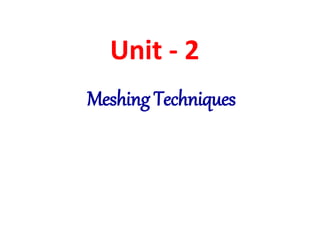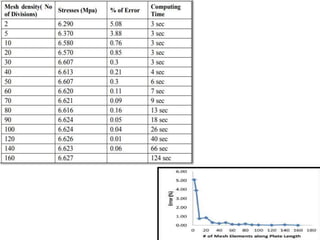The document discusses various meshing techniques and element quality criteria important for finite element analysis. It describes how to discretize a structure using suitable elements of appropriate shape, size and number. 1D, 2D and 3D element types are introduced along with the importance of element quality parameters like skewness, aspect ratio, warping factor and Jacobian. Maintaining good element quality is crucial for accurate results as degraded elements can underestimate stresses and strains. The document also covers mesh refinement methods and considerations for meshing structures such as handling discontinuities and utilizing symmetry.











![Importance of Element Quality
• The shape of Elements in FE Analysis must be distorted from their Ideal
shapes when meshing the irregular or complex geometric shapes.
• Every element is designed to work properly within a certain range of
shape distortion. Exactly how much distortion and what type of
distortion is allowed before an element degenerate depends on factors
such as element type, numerical procedures used in the element
design, and so forth.
• The Ideal shape of [2D Elements] a triangular element is an equilateral
triangle and a quadrilateral; it is a square.
• The Ideal shape of [3D Elements] a Tetrahedron element is a Regular or
Isosceles Tetrahedron and a Hexahedron, it is a Cube etc.,
• If the actual shape that the element assumes after mapping onto
model geometry differs too much from the natural shape, the element
becomes degenerated and produces erroneous results.](https://image.slidesharecdn.com/unit2-meshingtechniques-230503062007-0002362c/85/Unit-2-Meshing-Techniques-pptx-12-320.jpg)









![A] NODES AT DISCONTINUITIES
In a structure we come across the following types of
discontinuities:
(a) Geometric discontinuity
(b) Discontinuity of Loads
(c) Discontinuity of the Boundary conditions
(d) Material Discontinuity.](https://image.slidesharecdn.com/unit2-meshingtechniques-230503062007-0002362c/85/Unit-2-Meshing-Techniques-pptx-22-320.jpg)




![B] REFINING MESH
To get better results the finite element mesh should be refined in the
following situations
a. To approximate curved boundary of the structure
b. At the places of high stress gradients.
Refined mesh near curved boundary of a
dam](https://image.slidesharecdn.com/unit2-meshingtechniques-230503062007-0002362c/85/Unit-2-Meshing-Techniques-pptx-27-320.jpg)
![C] USE OF SYMMETRY
Wherever there is symmetry in the problem it should be made use. By
doing so lot of memory requirement is reduced or in other words we can
use more elements (refined mesh) for the same capacity of computer
memory. When symmetry is to be used, it is to be noted that at right angles
to the line of symmetry displacement is zero. In the tension bar example
shown in Fig. biaxial symmetry of the problem is utilized and only quarter
of the bar is taken for the analysis.
Discretization of half of Tension Flat](https://image.slidesharecdn.com/unit2-meshingtechniques-230503062007-0002362c/85/Unit-2-Meshing-Techniques-pptx-28-320.jpg)
![D] ELEMENT ASPECT RATIO
The shape of the element also affects the accuracy of
analysis.
Definition - The ratio of largest to smallest size in an
element
The conclusion of many researchers is aspect ratio should
be as close to unity as possible.](https://image.slidesharecdn.com/unit2-meshingtechniques-230503062007-0002362c/85/Unit-2-Meshing-Techniques-pptx-29-320.jpg)

![G] Mesh Quality
In a finite element mesh, it is generally desirable to avoid
elements of high aspect ratio. The presence of such elements
can have adverse effects on the analysis results.
•In general, such elements can influence analysis results, and
lead to misleading and inaccurate results, which are
dependent on the mesh.
•In extreme cases, such elements may even be responsible
for non-convergence of the finite element solution, and the
analysis will be aborted.](https://image.slidesharecdn.com/unit2-meshingtechniques-230503062007-0002362c/85/Unit-2-Meshing-Techniques-pptx-31-320.jpg)



![F] Mesh-geometry association
Creating an association between orphan mesh entities (elements,
element faces, element edges, and nodes) and adjacent geometry,
allows the transfer of loads, interactions, and boundary conditions
from the geometry to the mesh.
Figure 1 shows an example of the use of mesh-geometry association
between a two-dimensional orphan element region and an adjoining
geometric region.](https://image.slidesharecdn.com/unit2-meshingtechniques-230503062007-0002362c/85/Unit-2-Meshing-Techniques-pptx-35-320.jpg)




















